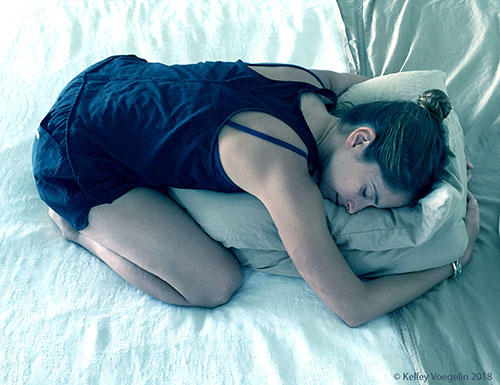Yoga doesn’t have to happen in a yoga studio, let alone on a yoga mat. You can even create a sweet and simple practice in the coziness of your bed. Bedtime yoga helps you wind down, clear the story of your day and surrender to slumber.

How to prepare for bed yoga
Before you get in bed, it’s important to take care of your entire pre-sleep routine first: bathroom, alarm and say goodnight to your phone. Clear the bed and room of clutter, turn off the lights and close the door so you won’t be disturbed.
Finally, smooth out your blanket to create a clear surface for your bedtime practice,with two or three pillows available nearby.
Connecting with your breath and setting an intention
Start by creating an intentional shift of pace. Sit cross-legged on top of a pillow and close your eyes or soften your gaze downward. Take a moment to settle into the quiet and clear your mind and body with a few rounds of breath that fill to the depth of your lungs.
Then consider setting an intention for yourself. It can be short, sweet and simple— perhaps releasing your day, calming your body and mind, inviting good dreams into your sleep. After you’ve taken this moment to pause, move into your practice.
Embrace this simple yoga routine
The poses in this sequence turn down your active (sympathetic) nervous system and switch on your relaxed (parasympathetic) nervous system, setting the scene for a good night’s sleep.
1. Child’s Pose (Balasana)
Bringing your head and heart forward — and down — slows down your thoughts and energy,cools the mind and pacifies the nerves. This pose is shown at the top of the page.
Stack pillows in front of you to create a soft, fluffy bolster. Sit on your shins with your knees around the pillows, and fold your torso forward over them. Your arms can gently hug the pillows. Turn your head to one side, close your eyes, and breathe softly. After several minutes, turn your head the other way.
2. Reclining Bound Angle (Baddha Konasana)

This pose is comfy, cozy and calming.
Behind you, use two pillows to make the shape of a capital “T.” Recline with the bottom pillow under your low and upper back, and your head on the other pillow.Bring the soles of your feet together and allow your knees to gently fan out wide.
Another option for this pose: use pillows under the knees to support the outer hips with a third pillow under your head.
With either variation, be sure to bathe yourself with breath. Allow your belly to rise softly with the height of each inhalation and then gently deflate upon exhaling.Stay for as long as you like.
3. Reclining Twist (Jathara Parivartanasana)

This posture removes stiffness in the shoulders, back and hips.
Lie on your back with a pillow supporting your head. Bend your knees and allow them to fall to the left as your hips can gently slide to the right. Use another pillow as a landing pad for the legs, or place it between your knees.
Either extend your arms wide or place the hands upon your body. Do not force the twist but instead, allow time to let the shape unfold from within. Breathe ever so softly. After a few minutes, switch sides.
4. Corpse Pose (Savasana)

This supremely relaxing posture prepares the mind and body for repose.
Now you can finally get under the covers and tuck yourself in. With a pillow under your head, lie flat on your back with arms and legs stretched evenly out from your heart, spine and belly. Turn your palms up and let your feet release outward. Close your eyes and slow down your breathing, allowing each exhalation to be longer each time which invites exquisite calm.
If lying on your back isn’t comfortable, try side-lying Savasana. Lie on your right side with one pillow under your head and another between your bent knees or to hug. Lying on your right help encourage left nostril breathing. Breathing through the left side of the body is known to decrease blood sugar, heart rate,and blinking. The left channel of the subtle body (Ida Nadi) is associated with energies that are cooling, restorative and relaxing.
The facts about yoga, your bed and sleep
Yoga is proven to help us sleep better because:
- Deeper breathing calms the nervous system and draws us toward relaxation.
- Stretching and twisting our muscles and organs at night releases tension we’ve been storing up all day.
- Yoga reduces stress and anxiety — both of which rattle sleep and prevent good rest.
- Yoga and meditation help clear the head of excess thoughts and worries.
Choose the poses that work for you and do them in any order you like. But remember— it’s important to take this intentional time so you can release your day and expel anything you don’t want to take with you into slumber.
Embrace the quiet time, breathe slowly, and allow yourself to slip into your well-deserved night’s rest.
 |
Dr. Mary James, ND gives you tips for resetting your inner clock for better sleep in her popular article. |










